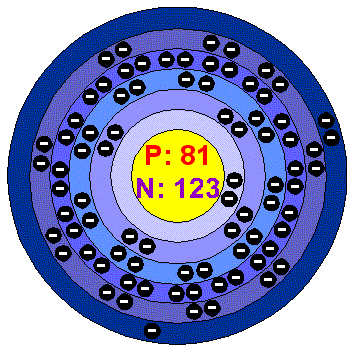|
When
freshly exposed to air, Thallium exhibits a metallic lustre, but soon
develops a blueish-grey tinge, resembling lead in appearance. A heavy
oxide builds up on Thallium if left in air, and in the presence of water
the hydroxide is formed. The metal is very soft and malleable. It can be
cut with a knife.
Applications
Thallium is used for making low-melting point
special glass for highly reflective lenses. Thallium salts are used as
reagents in chemical research. Thallium sulphate is still sold in
developing countries where it is still permitted as a pesticide,
although banned in Western countries. Since its electrical conductivity
changes with exposure to infrared light, it is used in photocells. It is
used for sink-float separation of minerals. Thallium amalgam is used in
thermometers for low temperature, because it freezes at -58 °C (pure
Mercury freezes at -38 °C).
Thallium in the environment
Thallium is not a rare element; it is 10 times more
abundant than Silver. The element is widely dispersed, mainly in
Potassium minerals such as sylvite and pollucite. Thallium minerals are
rare, but a few are known, such as crookesirte and lorandite. World
production of Thallium compound is around 30 tonnes per year. There has
been no assessment of how great the reserves are.
Thallium is partially water-soluble and
consequentially it can spread with groundwater when soils contain
large amounts of the component. Thallium can also spread by
adsorption on sludge. There are indications that Thallium is
fairly mobile within soils.
The element and its compounds are toxic and should be
handled carefully.
Thallium occurs in the environment naturally
in small amounts. It is not applied very widely by humans, merely
as rat poison and as a substance in electro-technical and chemical
industries. These applications can cause human exposure to
Thallium substances.
The human body absorbs Thallium very effectively, especially
through the skin, the breathing organs and the digestive tract.
Thallium poisoning is mainly caused by accidental uptake of rat
poison, which contains large amounts of Thallium sulphate.
Consequently, stomachaches will appear and the nervous system will
be damaged. In some cases the damage is so irreversible that death
will soon follow. When a human survives Thallium poisoning often
consequences of disturbances of the nervous system, such as
trembling, paralyses and behavioural changes will remain. With
unborn children Thallium poisoning can cause congenital disorders.
Due to accumulation of Thallium in the bodies of humans, chronic
effects consist, such as tiredness, headaches, depressions, lack
of appetite, leg pains, hair loss and disturbances of the sight.
Further effects that can be related to Thallium poisoning are
nerve pains and joint pains. These are consequences of Thallium
uptake through food.
There has been no significant contamination
of the environment by Thallium from industry, unlike that caused
by its neighbors in the periodic table, Mercury and lead.
Thallium is very toxic to rats and is applied as a rat pesticide
because of this. Thallium also has negative effects upon plants,
such as colour changes in leaves and growth declines. Mammals,
such as rabbits, are just as susceptible to the toxic effects of
Thallium as humans.
|
